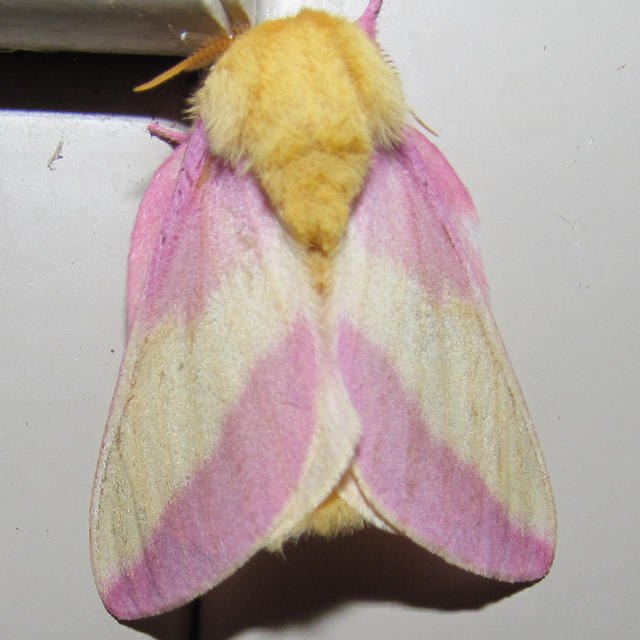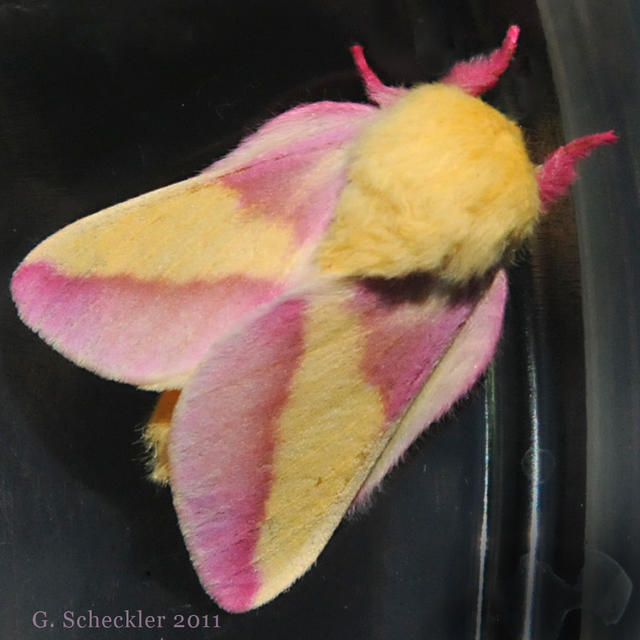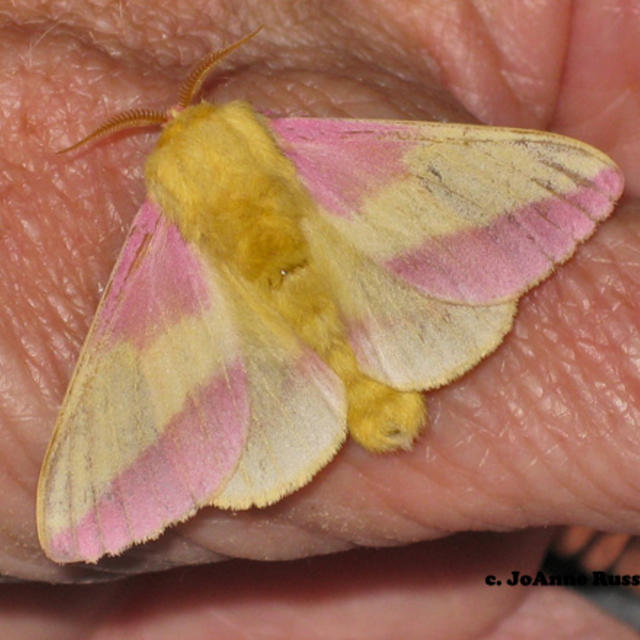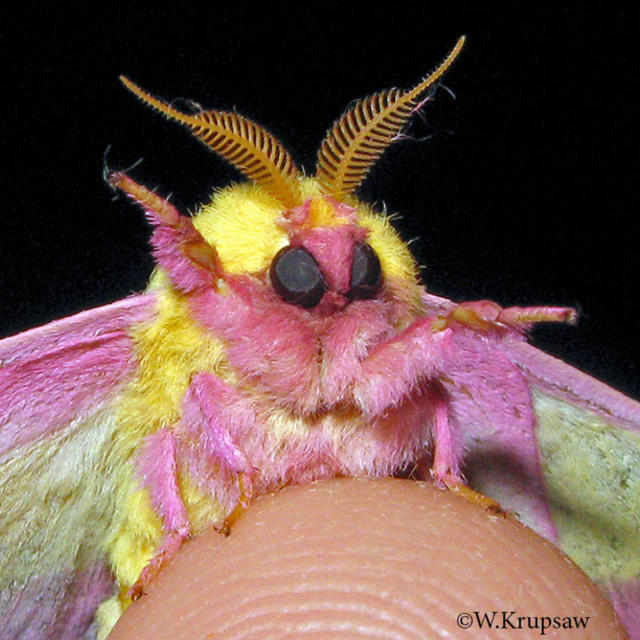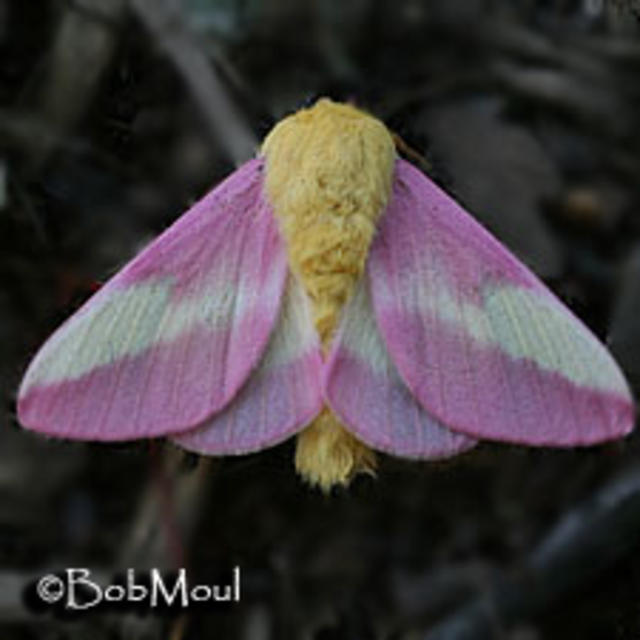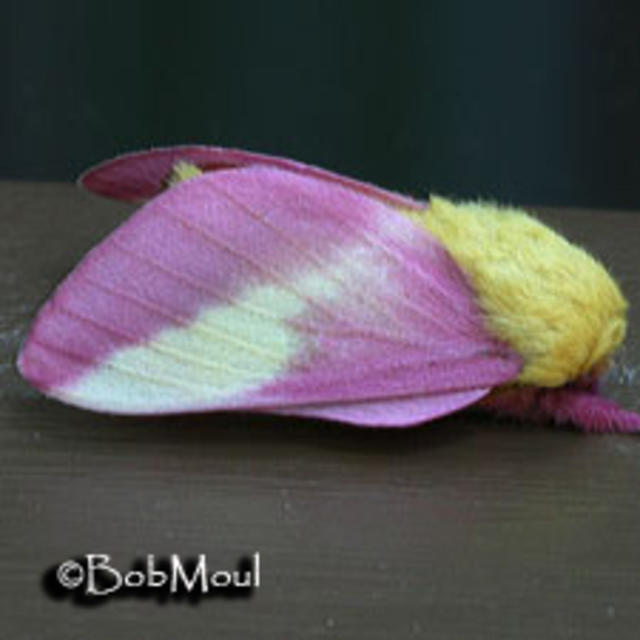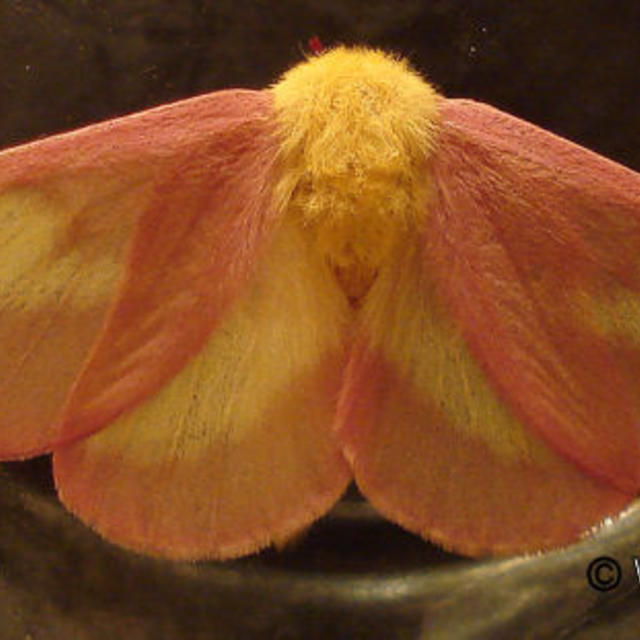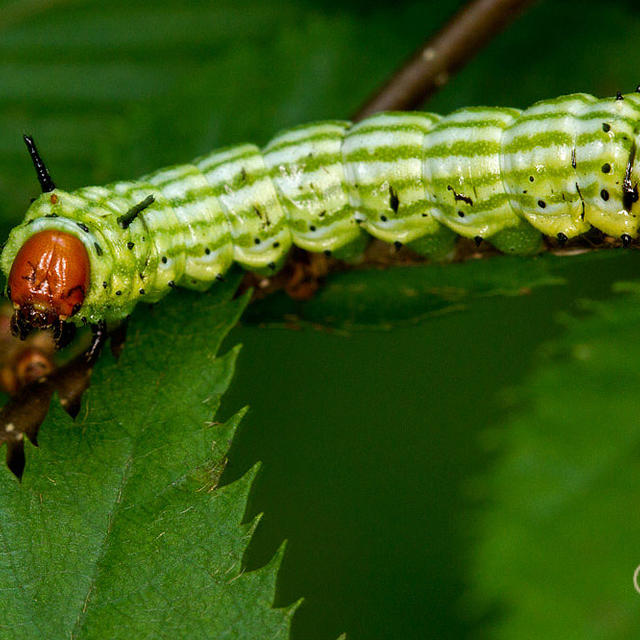Rosy maple moth
Dryocampa rubicunda (Fabricius, 1793)
Family: Saturniidae
Subfamily: Ceratocampinae
Identification: Extremely variable in color. Upperside of wing is yellow to cream to white with pink at the margins and bases of the wings. The amount of pink can vary from covering most of the wing to being absent altogether. Form alba occurs in Missouri and is all white or white with some pink markings.
Wing Span: 1 5/16 - 2 1/16 inches (3.4 - 5.2 cm).
Life History: Adults emerge in the late afternoon and mate in the late evening. Females begin laying eggs at dusk the next day in groups of 10-30 on leaves of the host plant. Eggs hatch in about 2 weeks and feed gregariously when young. Older caterpillars feed alone. Fully-grown caterpillars pupate and overwinter in shallow underground chambers.
Flight: One brood in the north from May-August,two broods in the south from April-September, possibly three broods in the Deep South and Florida from March-October.
Caterpillar Hosts: Maple trees including red maple (Acer rubrum), sugar maple (A. saccharum), and silver maple (A. saccharinum); and oak trees including turkey oak (Quercus laevis).
Adult Food: Adults do not feed.
Habitat: Deciduous forests.
Range: Nova Scotia west through Quebec to Ontario and Minnesota; south to Dade County, Florida, the Gulf Coast, and east Texas.
Conservation: Caterpillars can become pests by defoliating trees during occasional population explosions.
NCGR: G5 - Demonstrably secure globally, though it may be quite rare in parts of its range, especially at the periphery.
Management Needs: None reported.
Get your BAMONA Gear!
Please donate!
We depend on donations to keep Butterflies and Moths of North America freely available. We want to express our gratitude to all who showed their support by making a contribution this year. You can donate to support this project at any time.
Advertise with us!
Do you have a product or service that you think would interest BAMONA users? If you would like to advertise on this website, contact us by email, or use the contact form and select the "Advertising" category.
Verified Sightings
Displaying 1 - 24 of 1572 verified sightings

Observation date: May 09, 2024
Submitted by: polkyj7710
Region: Garland County, Arkansas, United States
Verified by: curtis.lehman
Verified date: Mar 18, 2025

Observation date: Aug 07, 2019
Submitted by: titoToucan
Region: Clermont County, Ohio, United States
Verified by: rogerdowner
Verified date: Oct 09, 2024

Observation date: Jul 14, 2023
Submitted by: gjkoppel
Region: Highland County, Ohio, United States
Verified by: rogerdowner
Verified date: Sep 22, 2024

Observation date: Jul 29, 2024
Submitted by: Huber4
Region: Newton County, Mississippi, United States
Verified by: stomlins701
Verified date: Sep 05, 2024

Observation date: Aug 03, 2024
Submitted by: mpasour
Region: Mecklenburg County, North Carolina, United States
Verified by: rogerdowner
Verified date: Sep 05, 2024

Observation date: Aug 06, 2024
Submitted by: ButtahflyEtn37354
Region: Monroe County, Tennessee, United States
Verified by: rogerdowner
Verified date: Aug 13, 2024

Observation date: Aug 09, 2024
Submitted by: PinFeathers
Region: New Brunswick, Canada
Verified by: Sue Gregoire
Verified date: Aug 11, 2024

Observation date: Aug 07, 2024
Submitted by: Osangar
Region: Wake County, North Carolina, United States
Verified by: rogerdowner
Verified date: Aug 07, 2024

Observation date: Aug 06, 2024
Submitted by: WMarshall
Region: Floyd County, Virginia, United States
Verified by: rogerdowner
Verified date: Aug 06, 2024

Observation date: Aug 04, 2024
Submitted by: Salisburybrett
Region: Wake County, North Carolina, United States
Verified by: rogerdowner
Verified date: Aug 05, 2024

Observation date: Jul 15, 2021
Submitted by: cashewmommi
Region: Quebec, Canada
Verified by: Sue Gregoire
Verified date: Aug 05, 2024

Observation date: Jul 11, 2024
Submitted by: Philip Borntrager
Region: Rockingham County, Virginia, United States
Verified by: rogerdowner
Verified date: Aug 01, 2024

Observation date: Jul 04, 2022
Submitted by: keraunophile
Region: Watauga County, North Carolina, United States
Verified by: rogerdowner
Verified date: Jul 27, 2024

Observation date: Jul 26, 2024
Submitted by: Moth_Observer01
Region: Nelson County, Kentucky, United States
Verified by: rogerdowner
Verified date: Jul 26, 2024

Observation date: Apr 24, 2024
Submitted by: Codymm
Region: Greenup County, Kentucky, United States
Verified by: rogerdowner
Verified date: Jul 16, 2024

Observation date: Jul 10, 2024
Submitted by: Bperkins
Region: Sullivan County, New York, United States
Verified by: jmgesell
Verified date: Jul 10, 2024

Observation date: May 28, 2024
Submitted by: Ken Cheeks
Region: Edgefield County, South Carolina, United States
Verified by: rogerdowner
Verified date: Jul 07, 2024

Observation date: Jul 06, 2024
Submitted by: jadedrake2024
Region: Hancock County, Maine, United States
Verified by: Sue Gregoire
Verified date: Jul 07, 2024

Observation date: Jun 05, 2024
Submitted by: Betsy Higgins
Region: Coos County, New Hampshire, United States
Verified by: rogerdowner
Verified date: Jun 28, 2024

Observation date: Jun 26, 2024
Submitted by: rocksnstars
Region: Oxford County, Maine, United States
Verified by: Sue Gregoire
Verified date: Jun 27, 2024

Observation date: Jun 24, 2024
Submitted by: Christopher S
Region: St. Clair County, Michigan, United States
Verified by: jwileyrains
Verified date: Jun 24, 2024

Observation date: Jun 21, 2024
Submitted by: Ozark_Bill
Region: Franklin County, Missouri, United States
Verified by: jwileyrains
Verified date: Jun 23, 2024

Observation date: Jun 17, 2024
Submitted by: Bob Jacobson
Region: Chippewa County, Wisconsin, United States
Verified by: Ilona L.
Verified date: Jun 18, 2024

Observation date: Jun 15, 2024
Submitted by: WMarshall
Region: Floyd County, Virginia, United States
Verified by: rogerdowner
Verified date: Jun 16, 2024
- 1 of 66
- next ›

